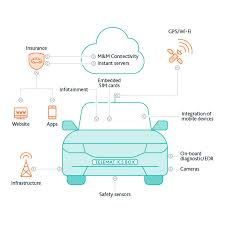Labels like ‘locally sourced’ and ‘farm to table’ are ways that we discern the quality of our food. They are not generally applicable to transportation as they conjure images of healthy edibles in a reputable supply chain. Until now, locally sourced has not been important in the automotive realm. In fact, car shoppers often paid a premium for vehicles manufactured overseas since they were perceived to be of higher quality and better design.
But if a newly manufactured vehicle carried a passport it would have acquired many visas. The hardware and software for vehicles are sourced from all over the world, and that is increasingly a problem. The final assembly plant might be in Mexico, the U.S., or Germany, and the components would come from a far-flung network, perhaps not all of them trust-worthy.
Rolling Stock problem:
It is not an entirely new issue for mobility and transportation. More than ten years ago large municipal transit providers, like the Philadelphia SEPTA, the Boston MBTA, and others, needed to modernize their rail fleets. There was no domestic company that made the equipment any longer so the state owned China Railway Rolling Stock corporation (CRRC) put in a low-bid and won four of the five largest rail car contracts. During the production of the vehicles concerns began to be raised that cameras or sensors in the vehicles might allow surveillance from afar. More maliciously, flaws in the software, intentional or not, might cede control of train operations.
During roughly the same time frame, car manufacturers began to equip their vehicles with cameras and sensors, most notably Tesla. The vehicles relied on over-the-air updates and some features were only available through a driver’s personal phone. Around 2017, the U.S. government stepped in too and the GSA began requiring all government owned and leased vehicles to install two-way communications, called telematics, to improve fleet management. In General Motors vehicles, OnStar, deployed Internet enabled networks with a bread-crumb trail.
Cars or Computers?
Today, more and more new vehicles depend on OnStar products and over-the-air software updates. They also collect ever-increasing amounts of data about the vehicle and the driver. The modern car is said to have about half a dozen computers that generate more than 300 gigabytes of data per hour. But like any computer system, there can be hacks or vulnerabilities that can expose, or compromise, a system. Just last month (September, 2024) there were reports that Kia vehicles had an open-door to hackers, just through reading license plates.
September, 2024
When consumers buy a new vehicle, they are relatively uninformed about such threats. However, they got a wake-up call, this September (2024). In the Middle East hand-held devices, specifically walkie-talkies and pagers, exploded, killing tens and injuring thousands. The hand- held devices were activated through an over-the-air signal that went off as the hapless user went to check for an incoming message or beep. News reports speculate that the devices were manufactured in a Taipei factory but were planted with hidden explosives as they were shipped through Europe.
While that deadly explosion was confined to warfare, there is a parallel instance that could take place in future mobility.
Depending on where a vehicle is built and who monitors the supply chain, a ticking-bomb of software and incendiaries could go undetected. It could be used as a point of blackmail during a negotiation or outright war. For example, a malicious actor, having gained access to a vehicle control system, could signal a car to accelerate when the driver steps on the brake, or force the vehicle to take an unexpected drift out of lane. Or, this scenario could be activated across many vehicles on many roads, like the explosion that occurred in September. It would result in simultaneous deaths, panic, and mayhem. It may not be coincidental that the U.S. Commerce Department has just sought a ban on software and hardware for connected and autonomous vehicles, if it is made by the Chinese or Russians.
It used to be sufficient to do bomb sweeps inside and outside a vehicle before a head-of-state or high ranking dignitary took a trip. Today it’s a far bigger challenge as the teleconnected, telematic vehicle is a “24/7” sending and receiving machine. We haven’t caught up with a way, similar to the way we label food, to understand what seeds were used and how they got planted.

